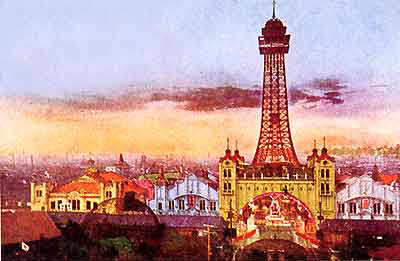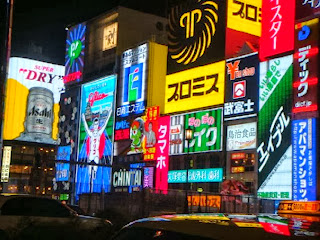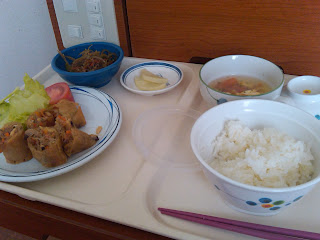Rediscover Good Japan ~Vol.5
The finale of the series is my favorite love and hate relationship city, Osaka;
the second largest economy city in Japan after Tokyo.
It is an industrial, merchants city.
Osaka is a sister city of Chicago, San Francisco, Shanghai, and other major cities all over the world.
Osaka city locates almost center of Osaka prefecture, which consists with 32 other cities, 9 towns and 1 village.
There are 22 cities that have more than 100,000 population each in Osaka prefecture.
I grew up in one of 24 districts in Osaka city, which I used to think it was like living in ghetto for life (well..because it's known for pretty bad reputation for snatching and stuff) but now I really know it was rather a nice, peaceful neighborhood.
The district with little over 130,000 population is known for the highest foreigner population in the city of Osaka and many are Korean and Chinese immigrants.
Since I grew up in the community where kids didn't care where we came from or what we are, I naturally became more adopted to the mixed culture neighborhoods in Osaka.
To me, these mixture of different cultures created the unique, exotic, could even be chaotic but beautiful things about Osaka.
And this certain kind of beautiful chaos is made by the people, which
I think the most attractive thing about Osaka; they are frank and easy going people. Osaka-jin (Osakans) are also known for their brutally honest openness but probably they are mostly known for being funny.
There is a saying in Japan, "to become Edokko (Tokyo-jin/Tokyo people), takes three generations. To become Kyoto-jin/Kyoto people, takes ten generations. To become Naniwakko (Osaka-jin/Osaka people), takes one generation."
This phrase shows how difficult to become Tokyo-jin and Kyoto-jin, specially Kyoto which used to be the capital of Japan is where people prefer keeping new things out of the city. On the other hand, Osaka, where people welcome anything and anyone seems to be much more reachable by the outsiders.
Yes, I think people in Osaka are rather straight forward and honest yet, therefore, they could be taken little bit rude by others. But the truth is they are mostly sweet and genuinely nice, at least they are more kind than I am.
I have to admit, growing up in a city like Osaka was pretty damn good thing for me.
There are just way too many interesting areas in Osaka, but I particularly would like to talk about this deep, a little hard core old Osaka area called Shinsekai. (Yea, I know long intro..sorry.)
Shinsekai today
image copy right by Pigeon Dynamite
Shinsekai means New World in English.
And to me, it's been always rather strange world than the new world.
Since I was little, without being told by anybody but I knew the area was different from any other downtown areas in Osaka.
Even now, with those bigger areas of Osaka such as Umeda and Namba being completely rebuilt and packed with tons of shopping centers and buildings, Shinsekai has been always rougher than other downtowns.
Today, Shinsekai leaves certain impression of old Showa period (1926~1989) of Osaka and has become more of a tourist attraction.
This district, somewhat peculiar and strange, has some interesting history behind it.
Shinsekai was planned initially based upon Paris and Coney Island in New York back in 1909.
They planned the south part of Shinsekai to be like Paris and put Shinsekai version of Eiffel tower, Tsutenkaku in the north side.
The first generation of the tower stood up on the gate that was designed based on Arc de triomphe de l'Étoile in Paris.
In 1912, mocking Luna Park in Coney Island, Shinsekai version of Luna Park was opened. The theme park and the first Tsutenkaku was connected with the cable car/aerial tramway.
There was a music hall, a fun house, a hot spring spa, and shopping malls inside of the European looking buildings.
Luna Park in Shinsekai, Osaka

There are 22 cities that have more than 100,000 population each in Osaka prefecture.
I grew up in one of 24 districts in Osaka city, which I used to think it was like living in ghetto for life (well..because it's known for pretty bad reputation for snatching and stuff) but now I really know it was rather a nice, peaceful neighborhood.
The district with little over 130,000 population is known for the highest foreigner population in the city of Osaka and many are Korean and Chinese immigrants.
Since I grew up in the community where kids didn't care where we came from or what we are, I naturally became more adopted to the mixed culture neighborhoods in Osaka.
To me, these mixture of different cultures created the unique, exotic, could even be chaotic but beautiful things about Osaka.
I think the most attractive thing about Osaka; they are frank and easy going people. Osaka-jin (Osakans) are also known for their brutally honest openness but probably they are mostly known for being funny.
There is a saying in Japan, "to become Edokko (Tokyo-jin/Tokyo people), takes three generations. To become Kyoto-jin/Kyoto people, takes ten generations. To become Naniwakko (Osaka-jin/Osaka people), takes one generation."
This phrase shows how difficult to become Tokyo-jin and Kyoto-jin, specially Kyoto which used to be the capital of Japan is where people prefer keeping new things out of the city. On the other hand, Osaka, where people welcome anything and anyone seems to be much more reachable by the outsiders.
Yes, I think people in Osaka are rather straight forward and honest yet, therefore, they could be taken little bit rude by others. But the truth is they are mostly sweet and genuinely nice, at least they are more kind than I am.
I have to admit, growing up in a city like Osaka was pretty damn good thing for me.
There are just way too many interesting areas in Osaka, but I particularly would like to talk about this deep, a little hard core old Osaka area called Shinsekai. (Yea, I know long intro..sorry.)
Shinsekai today
image copy right by Pigeon Dynamite
Shinsekai means New World in English.
And to me, it's been always rather strange world than the new world.
Since I was little, without being told by anybody but I knew the area was different from any other downtown areas in Osaka.
Even now, with those bigger areas of Osaka such as Umeda and Namba being completely rebuilt and packed with tons of shopping centers and buildings, Shinsekai has been always rougher than other downtowns.
Today, Shinsekai leaves certain impression of old Showa period (1926~1989) of Osaka and has become more of a tourist attraction.
This district, somewhat peculiar and strange, has some interesting history behind it.
Shinsekai was planned initially based upon Paris and Coney Island in New York back in 1909.
They planned the south part of Shinsekai to be like Paris and put Shinsekai version of Eiffel tower, Tsutenkaku in the north side.
The first generation of the tower stood up on the gate that was designed based on Arc de triomphe de l'Étoile in Paris.
In 1912, mocking Luna Park in Coney Island, Shinsekai version of Luna Park was opened. The theme park and the first Tsutenkaku was connected with the cable car/aerial tramway.
There was a music hall, a fun house, a hot spring spa, and shopping malls inside of the European looking buildings.
Luna Park in Shinsekai, Osaka

The first generation of Tsutenkaku tower
Images from http://dateclub210.blog43.fc2.com/
As Luna Park was opened, people brought more businesses around Shinsekai;
There were restaurants, a zoo, (i.e. Tennoji Zoo, which still exists today) theaters, cinemas, an European style Sumo stadium, which was turned into a movie theater after the business failure in 1928 but the building was lost by bombing of Osaka during WWII, and Tobita Yukaku, which was the largest brothel district until 1958 in the western Japan.
Thus, Shinsekai became the "it" district (and the "it" red light district at the same time.)
Image of Hot Spring Spa in Shinsekai
http://dateclub210.blog43.fc2.com/blog-category-2.html
However, while Shinsekai flourished and had its time, Luna Park was losing its popularity and finally closed in 1925.
The original Tsutenkaku tower was also damaged by the fire and was taken down by the government during WWII in 1943.
Shinsekai came to one end after the bombing of Osaka in 1945; the city was destroyed so was Shinsekai. Shinsekai became the ruins.
However, Osakans demands for entertainment and life first brought the markets in Shinsekai after the war. Many theaters and restaurants came back and brought more people back to Shinsekai.
People started to talk about the construction of Tsutenkaku tower to Shinsekai around 1953 and in 1956, the second generation of Tsutenkaku was built slightly north from the original location.
Second generation Tsutenkaku
image copy right by Pigeon Dynamite
Shinsekai had its light back again once more, but as modern transportation spread and other nearby areas such as Namba and Umeda developed to become bigger and more urbanized downtown, people slowly started to forget Shinsekai.
Until early 2000s, Shinsekai was kind of something that modern Osakans left together with Showa period,
but its retro nostalgic atmosphere and the people who lived there always reminded Osakans of the time they had forgotten.
Ironically, Shinsekai, the new world, became popular again for its Showa retro style.
Today, families come to Shinsekai, go up to the Tsutenkaku tower, and have Shinsekai's specialty Kushikatsu. (Japanese deep fried vegetables and kebab)
There is Shinsekai's famous god, Billiken, the god of things as they ought to be.
Billiken was in the Luna Park when they built the theme park in Shinsekai.
And he is up in Tsutenkaku today for people to rub back of his feet for good luck.
You can find him everywhere in Shinsekai. The two of them are inside of Tsutenkaku.
images copy right by Pigeon Dynamite
Shinsekai may not be as impressive as bigger, fancier areas like Umeda,
but the town that had blinked to peak the horizon gives us the sense of dream that people dreamed long time ago.
Tsutenkaku at night
image copy right by Pigeon Dynamite
So..this is the last post for the Good Japan series.
Images from http://dateclub210.blog43.fc2.com/
As Luna Park was opened, people brought more businesses around Shinsekai;
There were restaurants, a zoo, (i.e. Tennoji Zoo, which still exists today) theaters, cinemas, an European style Sumo stadium, which was turned into a movie theater after the business failure in 1928 but the building was lost by bombing of Osaka during WWII, and Tobita Yukaku, which was the largest brothel district until 1958 in the western Japan.
Thus, Shinsekai became the "it" district (and the "it" red light district at the same time.)
Image of Hot Spring Spa in Shinsekai
http://dateclub210.blog43.fc2.com/blog-category-2.html
However, while Shinsekai flourished and had its time, Luna Park was losing its popularity and finally closed in 1925.
The original Tsutenkaku tower was also damaged by the fire and was taken down by the government during WWII in 1943.
Shinsekai came to one end after the bombing of Osaka in 1945; the city was destroyed so was Shinsekai. Shinsekai became the ruins.
However, Osakans demands for entertainment and life first brought the markets in Shinsekai after the war. Many theaters and restaurants came back and brought more people back to Shinsekai.
People started to talk about the construction of Tsutenkaku tower to Shinsekai around 1953 and in 1956, the second generation of Tsutenkaku was built slightly north from the original location.
Second generation Tsutenkaku
image copy right by Pigeon Dynamite
Shinsekai had its light back again once more, but as modern transportation spread and other nearby areas such as Namba and Umeda developed to become bigger and more urbanized downtown, people slowly started to forget Shinsekai.
Until early 2000s, Shinsekai was kind of something that modern Osakans left together with Showa period,
but its retro nostalgic atmosphere and the people who lived there always reminded Osakans of the time they had forgotten.
Ironically, Shinsekai, the new world, became popular again for its Showa retro style.
Today, families come to Shinsekai, go up to the Tsutenkaku tower, and have Shinsekai's specialty Kushikatsu. (Japanese deep fried vegetables and kebab)
There is Shinsekai's famous god, Billiken, the god of things as they ought to be.
Billiken was in the Luna Park when they built the theme park in Shinsekai.
And he is up in Tsutenkaku today for people to rub back of his feet for good luck.
You can find him everywhere in Shinsekai. The two of them are inside of Tsutenkaku.
images copy right by Pigeon Dynamite
Shinsekai may not be as impressive as bigger, fancier areas like Umeda,
but the town that had blinked to peak the horizon gives us the sense of dream that people dreamed long time ago.
Tsutenkaku at night
image copy right by Pigeon Dynamite
So..this is the last post for the Good Japan series.
I thought I knew my country better but I only knew so little and there are just so much more to learn about it.
Hope I get to go back my country more often in the future to explore and rediscover more.
And hope the series made some of you get inspired to travel to this wonderful country.
Thanks for reading.
シリーズ最終回は、私の生まれ故郷でもある大阪です。
ある時は嫌いで、ある時は本当に一番好きな街です。
大阪はシカゴや、サンフランシスコ、上海などの世界でも有数の大都市と姉妹都市とされています。大阪府は合計で33の市と、9つの町と1つの村で構成されています。(村があることにちょっとびっくりしました実際。)
その実に22もの市がそれぞれ十万人を超える人口を持つ程人々が密集した街です。
私が育ったのは大阪市の24区あるうちのひとつで、昔はよくゲットー並みに荒んだ地域だと思っていましたが、(実際ひったくりとかすごかったので)今こうして色んな国や街を見てきて、
むしろ全く平和なとこで育ったんだなーと改めて思わされます。
この地区の人口はおよそ13万人程で、外国籍(主に朝鮮、韓国)の人口が大阪市で最も高い事でも有名です。
でも相手が外国籍とか、何処から来たとかそういった事を気にせず育ったので、自然とカルチャーのミックスされた地域に馴染む事ができました。
こういう場所で こそ、ちょっとコアでユニークで時には混沌としたものかも知れませんが、大阪らしいものが生まれてくるんだと思っていました。
そしてその混沌とした美は人々によって作られます。私が思うにその人々こそ、大阪の一番の魅力だったりすると思うのです。
大阪人というと、どぎつい程ストレートに正直でオープンでそして何より一番よく知られているのはそのユーモラスな性分だと思います。
Hope I get to go back my country more often in the future to explore and rediscover more.
And hope the series made some of you get inspired to travel to this wonderful country.
Thanks for reading.
シリーズ最終回は、私の生まれ故郷でもある大阪です。
ある時は嫌いで、ある時は本当に一番好きな街です。
大阪はシカゴや、サンフランシスコ、上海などの世界でも有数の大都市と姉妹都市とされています。大阪府は合計で33の市と、9つの町と1つの村で構成されています。(村があることにちょっとびっくりしました実際。)
その実に22もの市がそれぞれ十万人を超える人口を持つ程人々が密集した街です。
私が育ったのは大阪市の24区あるうちのひとつで、昔はよくゲットー並みに荒んだ地域だと思っていましたが、(実際ひったくりとかすごかったので)今こうして色んな国や街を見てきて、
むしろ全く平和なとこで育ったんだなーと改めて思わされます。
この地区の人口はおよそ13万人程で、外国籍(主に朝鮮、韓国)の人口が大阪市で最も高い事でも有名です。
でも相手が外国籍とか、何処から来たとかそういった事を気にせず育ったので、自然とカルチャーのミックスされた地域に馴染む事ができました。
こういう場所で こそ、ちょっとコアでユニークで時には混沌としたものかも知れませんが、大阪らしいものが生まれてくるんだと思っていました。
そしてその混沌とした美は人々によって作られます。私が思うにその人々こそ、大阪の一番の魅力だったりすると思うのです。
大阪人というと、どぎつい程ストレートに正直でオープンでそして何より一番よく知られているのはそのユーモラスな性分だと思います。
江戸は三代、京は十代、浪速は一代、と言われるように、京都人になるには十代かかるが大阪人になるには一代で良いと現される程目新しいものが好きで、来るもの拒まず的オープンな大阪の姿勢が好感を持たれる理由だと思います。
確かにそのストレートな表現や正直すぎる所が失礼と捉える人もいるかも知れませんが、
本当に根っからの意地悪では無く大阪人独特の愛嬌だったりするので
本来はとても親切な人が多い街だと思っています。
(最低でも私よりも親切な人達だと思います。)
今でこそ認めますが、大阪で育った事はだいぶラッキーだったと思います。
大阪には色々と面白いところがやたら多いのですが、
今回特にハードコアな大阪、新世界についてお話したいと思います。長い前触れすんません。
新世界は何故か物心付く頃から、特に誰に言われたでもなく何となく大阪でもちょっと変わったエリアである印象を持っていました。
今でさえ、大阪の梅田や難波のエリアの様な繁華街が軒並みリニューアルしていく様を横目に、新世界はずっとちょっと寂れた街のままです。
しかしながらその一風時代に取り残された感が、昭和の大阪の雰囲気を醸し出していて、
最近ではちょっとした観光スポットになっているのも事実です。
この奇妙なエリアには何とも興味深い歴史があります。
新世界の都市開発は1909年当初、パリとニューヨークのコーニーアイランドを模倣して計画が開始されました。
新世界の南側をパリのようにして、エッフェル塔をイメージした初代通天閣が北側に建設されました。
初代通天閣はエトワール凱旋門をイメージしてデザインされた門の上に直接建設されました。今思っても何ともめちゃくちゃで斬新な、ある意味大阪らしい事をやってのけたんですね。
確かにそのストレートな表現や正直すぎる所が失礼と捉える人もいるかも知れませんが、
本当に根っからの意地悪では無く大阪人独特の愛嬌だったりするので
本来はとても親切な人が多い街だと思っています。
(最低でも私よりも親切な人達だと思います。)
今でこそ認めますが、大阪で育った事はだいぶラッキーだったと思います。
大阪には色々と面白いところがやたら多いのですが、
今回特にハードコアな大阪、新世界についてお話したいと思います。長い前触れすんません。
新世界は何故か物心付く頃から、特に誰に言われたでもなく何となく大阪でもちょっと変わったエリアである印象を持っていました。
今でさえ、大阪の梅田や難波のエリアの様な繁華街が軒並みリニューアルしていく様を横目に、新世界はずっとちょっと寂れた街のままです。
しかしながらその一風時代に取り残された感が、昭和の大阪の雰囲気を醸し出していて、
最近ではちょっとした観光スポットになっているのも事実です。
この奇妙なエリアには何とも興味深い歴史があります。
新世界の都市開発は1909年当初、パリとニューヨークのコーニーアイランドを模倣して計画が開始されました。
新世界の南側をパリのようにして、エッフェル塔をイメージした初代通天閣が北側に建設されました。
初代通天閣はエトワール凱旋門をイメージしてデザインされた門の上に直接建設されました。今思っても何ともめちゃくちゃで斬新な、ある意味大阪らしい事をやってのけたんですね。
1912年にはコーニーアイランドにあるテーマパーク、ルナパークを真似た、新世界ルナパークが開園。そのテーマパークと初代通天閣は当時でも珍しかったケーブルカーでつながっていました。
当時の写真
ミュージックホールや大衆浴場、ショッピングセンターや映画館等が西洋風の建物として建設されていきました。
ルナパークがオープンすると人々は新世界の周りに次々と集まってきました。
道にはレストランが並び、動物園が作られ(現在の天王寺動 物園)映画館、劇場、中には西洋造りの相撲場所迄もあったそうです。しかしながら1928年には経営が破綻し、映画館に姿を変えた後大阪大空襲で失われて しまいます。その他、有名な赤線、飛田遊郭も誕生し、1958年に解体される迄西日本最大の歓楽街として名を馳せます。
当時の写真
ミュージックホールや大衆浴場、ショッピングセンターや映画館等が西洋風の建物として建設されていきました。
ルナパークがオープンすると人々は新世界の周りに次々と集まってきました。
道にはレストランが並び、動物園が作られ(現在の天王寺動 物園)映画館、劇場、中には西洋造りの相撲場所迄もあったそうです。しかしながら1928年には経営が破綻し、映画館に姿を変えた後大阪大空襲で失われて しまいます。その他、有名な赤線、飛田遊郭も誕生し、1958年に解体される迄西日本最大の歓楽街として名を馳せます。
しかしながら新世界がその繁栄を詠歌している間にルナパークの人気はみるみる劣り、人影は薄れていき1925年には閉園してしまいます。
初代通天閣も火災によって受けた損害と、鉄筋属の回収令で第二次世界大戦中に政府から解体されて 1943年新世界からその姿を消します。
新世界の終わりは1945年の大阪大空襲によって決定的なものとなります。
街は焼け落とされ、新世界はその他の大阪の街同様、一面焼け野原なります。
しかし戦後は大阪人の娯楽の需要も高まり、新世界に新たに人が集まってきました。
劇場や食堂が立ち並ぶようになり、人々は密かに通天閣の再建を話しだします。
最初は冗談でしたが、1956年、遂に現在の二代目通天閣が初代のものよりやや北側に建設されます。
初代通天閣も火災によって受けた損害と、鉄筋属の回収令で第二次世界大戦中に政府から解体されて 1943年新世界からその姿を消します。
新世界の終わりは1945年の大阪大空襲によって決定的なものとなります。
街は焼け落とされ、新世界はその他の大阪の街同様、一面焼け野原なります。
しかし戦後は大阪人の娯楽の需要も高まり、新世界に新たに人が集まってきました。
劇場や食堂が立ち並ぶようになり、人々は密かに通天閣の再建を話しだします。
最初は冗談でしたが、1956年、遂に現在の二代目通天閣が初代のものよりやや北側に建設されます。
新世界は再び光りを取り戻したかのように見えました、しかし交通の開発に乗り遅れ、梅田、難波エリアに人が集まり発展を遂げていくのに反してその人気は早くも陰りを見せます。
2000年前半迄、新世界は大阪人が昭和時代と共に置き去りにしてきたような印象でした。
しかし、そのレトロでノスタルジックな街と、何よりもずっとその地に住み続けてきた人達が、大阪人の忘れかけていた下町の生活を思い出させてくれました。
皮肉にも名前とは反対に、新世界は古きよき大阪の昭和スタイルを体現した街として再び注目を浴びるようになります。
今日では家族連れが新世界に行って、通天閣に登って、串カツを食べたりしています。
ルナパーク時代にも居たビリケンの神様が、新世界のあちこちで見られます。
勿論、本物は通天閣の最上階で足の裏をなでてもらうように祀られています。
新世界は他の街や、大阪の繁華街と比べても感動する程のものではないかもしれませんが、当時人々が夢みた街を見せてくれるようなそんな街である唯一の街だと思います。
最終回の日本再発見シリーズでしたが、結局自分が知ってると思っていた日本は、思っていたよりももっと奥深くておっきい国だと気づかされて終わりとなりました。
皆もこのシリーズを通して何か再発見してくれたら良いなと思います。
読んでくれたひと、ありがとう。
2000年前半迄、新世界は大阪人が昭和時代と共に置き去りにしてきたような印象でした。
しかし、そのレトロでノスタルジックな街と、何よりもずっとその地に住み続けてきた人達が、大阪人の忘れかけていた下町の生活を思い出させてくれました。
皮肉にも名前とは反対に、新世界は古きよき大阪の昭和スタイルを体現した街として再び注目を浴びるようになります。
今日では家族連れが新世界に行って、通天閣に登って、串カツを食べたりしています。
ルナパーク時代にも居たビリケンの神様が、新世界のあちこちで見られます。
勿論、本物は通天閣の最上階で足の裏をなでてもらうように祀られています。
新世界は他の街や、大阪の繁華街と比べても感動する程のものではないかもしれませんが、当時人々が夢みた街を見せてくれるようなそんな街である唯一の街だと思います。
最終回の日本再発見シリーズでしたが、結局自分が知ってると思っていた日本は、思っていたよりももっと奥深くておっきい国だと気づかされて終わりとなりました。
皆もこのシリーズを通して何か再発見してくれたら良いなと思います。
読んでくれたひと、ありがとう。




















Comments
Post a Comment